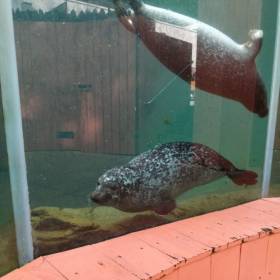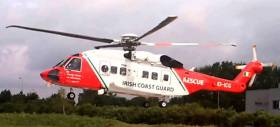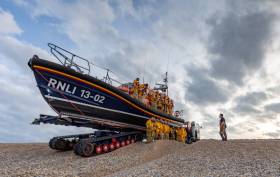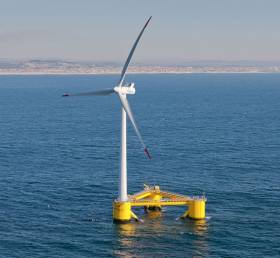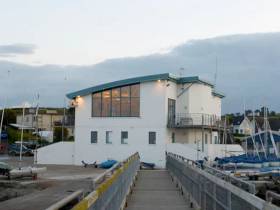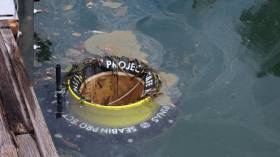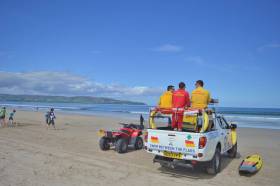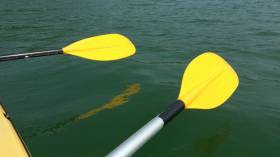Displaying items by tag: Northern Ireland
Tracking Of Juvenile Seals Is A First For Northern Ireland
Two juvenile seals named Ariel and Merida after the Disney princesses are part of a novel marine research project using the latest technology to record and understand harbour seals’ behaviour.
In a first for Northern Ireland, the Exploris Aquarium in Portaferry, Co Down has teamed up with University College Cork as part of the EU-funded, Loughs Agency-led SeaMonitor project to tag the female rehabilitated seals prior to their release from Knockinelder Beach in Co Down yesterday (Sunday 17 November).
Although seal pups have been rehabilitated and released by Exploris since 1989, this is the first time they have been tracked following release to give scientists a better understanding of how they fair post-release.
‘Although seal pups have been rehabilitated by Exploris since 1989, this is the first time they have been tracked following release’
Dr Mark Jessop, lead scientist from UCC, said: “We use state-of-the-art tags glued to the seals’ fur which drop off naturally during the seal’s annual moult, but until then provide information on where the seals are going as well as their dive behaviour.
“This gives us unique insights into post-rehabilitation survival and how juvenile seals learn to forage successfully in the wild.”
It is hoped that the data will be used to inform better management and protection for harbour seals.
The release of the two seals marks the first this season from Exploris Aquarium, NI’s only seal rehabilitation facility — with more releases to come.
“On average we take in about two dozen seals every year,” said Exploris curator, Peter Williams. “Seals are a protected species here in the UK and Europe so at Exploris we take in seal pups from all over the Northern Irish coast that have succumb to illness or have been affected by human interference and as a result abandoned by their mothers.”
Loughs Agency chief executive Sharon McMahon added: “This is an especially exciting time as the seals are the first species to be monitored since the project launched earlier this year.
“The agency is proud to be leading the way alongside expert colleagues from statutory and academic institutions and a range of stakeholders that will ultimately produce dynamic management plans for some of our most important and vulnerable species.”
‘These achievements ensure the safeguarding of our shared marine environment’
Discussing the importance of this work, Gina McIntyre, CEO of the Special EU Programmes Body, said: “I’m delighted to hear about the progress of this pioneering EU INTERREG cross-border project, which has seen a tremendous amount of development in such a short space of time.
“These achievements ensure the safeguarding of our shared marine environment and continue the necessary conservation work to protect priority species and habitats just like Ariel and Merida.
“The significant progress so far can be attributed to the strong cross-border partnership, combined with innovative marine technology. The expertise and determination of SeaMonitor’s project partners is helping push the boundaries of marine research in the seas not only around Northern Ireland, but in Ireland and Western Scotland.”
The work is part of SeaMonitor — a unique marine research project, the first of its kind in Europe, studying the seas around Ireland, Western Scotland and Northern Ireland.
The project is led by the Loughs Agency and supported by another eight leading marine research institutions, using innovative marine species tracking technology to better understand and protect vulnerable marine life in our oceans.
Patrick McGurgan, a Northern Ireland coroner, has recently called for the introduction of a law to make the wearing of lifejackets compulsory in Northern Ireland, writes Betty Armstrong.
Mr McGurgan had heard two inquests following separate drowning deaths on inland waters which occurred in June and September of last year.
Kenny Andrews (31) of Bangor died in Lower Lough Erne at Muckross Bay, near Kesh, after falling from a jet ski which he and his friend Stephen Kennedy had taken out on the lough on Sunday 9 September 2018.
After turning the craft to return to shore, it capsized and both men were thrown into the water. Neither was wearing a wetsuit or lifejacket. Mr Kennedy survived, and the search continued for the second man.
A multi-agency response got underway involving the Community Rescue Service (CRS), PSNI, Northern Ireland Fire and Rescue Service, RNLI and Irish Coast Guard helicopter from Sligo.
Searching continued throughout the evening before being stood down for the night late on Sunday. It resumed the next day.
Volunteers from Strabane CRS assisted in the search for Mr Andrews. The CRS is a charitable organisation operated by volunteers from across the community in Northern Ireland.
They managed, with the use of a multi-beam side scan sonar device, to locate Mr Andrews’ body and, in a joint operation, it was recovered by the PSNI dive team.
Muckross is situated on the north shore of Lower Lough Erne less than a mile from Kesh. It has beaches, picnic areas, a public jetty and a small marina and is said to be very popular with jet skiers.
The other incident was at Portglenone Marina on the banks of the Lower River Bann, when Edelle McGlade from Portstewart fell overboard in the early hours of Thursday 26 June last year.
The marina was in darkness as the lights automatically switch off after 11.30pm and when Ms McGlade stepped off the boat onto the pontoon, she lost her balance, causing the boat to move slightly away, and she fell into the water.
Despite efforts to rescue her she died. The CRS located her body and brought her ashore.
Out-But-In Brexit Customs Plan Has Hallmarks of Hastily Agreed Deal
In a major change from the original Northern Ireland backstop to avoid a hard border will require a huge leap into the unknown. It is the area of customs.
In practical terms, The Irish Times reports, this is the most complex part of the proposed Brexit plan to manage, with much of the small print yet to be written.
By dropping the idea of a EU-UK customs territory in the original plan, London and Brussels have agreed to allow Northern Ireland to leave the EU customs union while still applying the bloc’s customs rules there.
In an effort to maintain an open Irish Border, the EU is outsourcing checks on goods coming on to the island – and possibly into the EU market – to the UK authorities, with EU officials entitled to be present for checks at (ferry)ports in the North, Scotland and England.
Beyond a broad line of how it would work, there is little detail on how it will be managed. It is not clear what exactly would happen to a truckload of widgets travelling from Scotland to Northern Ireland through Belfast Port on to Dublin and then further into the EU market. A similar customs proposal from the UK was dismissed last year by Brussels as unworkable.
The newspaper has more here to read.
Afloat adds today marks the fourth and final day of the British Ports Association's annual conference which for the first time was hosted by Belfast Harbour. More than 300 industry representatives from across the UK and Ireland are attending.
As previously reported on Afloat, in advance of the event the BPA discussed the UK Government's 'new Brexit Border plan'.
Photographer Jack Lowe Tours Northern Ireland In Bid To Capture Every RNLI Lifeboat Station With Victorian Camera
Nearly five years into his epic project to photograph every RNLI lifeboat station with a Victorian-era camera, Jack Lowe this week began the Northern Ireland leg of the mammoth undertaking.
Starting yesterday (Tuesday 3 September) at Red Bay, Lowe’s four-week swing also includes Portrush tomorrow (Thursday 5 September), then Enniskillen, Carrybridge, Newcastle, Kilkeel, Portaferry, Donaghadee, Bangor and Larne before he returns home to Newcastle-upon-Tyne — via Portpatrick and Stranraer in Scotland.
Lowe will capture each lifeboat station and its crew using wet plate collodion, a process developed in the 1850s — when the RNLI also began — that creates stunning images on glass.
Following this 19th leg, the end of The Lifeboat Station Project will be in sight as the remaining station count will be down to double figures.
When completed, The Lifeboat Station Project will be the very first time every station on the RNLI network been documented as one complete body of work. It is also one of the biggest photographic projects ever undertaken, the RNLI says.
As with the rest of his adventure, Lowe travelled to Northern Ireland on Monday (2 September) with ‘Neena’, a decommissioned NHS ambulance purchased on eBay, which he converted into a mobile darkroom.
Along the way Lowe has been sharing the ups and downs of his mission on social media. He also makes videos and sound recordings, enabling his followers to get a real sense of what life is like within lifeboat communities.
Almost a year ago, Lowe reached the halfway mark of his epic project that previously took him to Ireland’s South Coast, where he completed his 100th station in Valentia.
By the end of September 2018, he estimates to have used around 1,500 glass plates, 120 litres of developer and 45 litres of collodion.
Lowe had also driven some 28,000 miles — the equivalent of more than once round the world.
“It’s a privilege spending time with so many lifeboat volunteers, preserving their bravery and devotion for future generations,” Lowe says.
“This journey is unprecedented in so many ways. The further I travel, the deeper the body of work becomes on just about every level and in ways that I could never have foreseen or imagined.”
The Lifeboat Station Project’s dedicated website has links to Lowe’s Facebook, Twitter and Instagram feeds, as well as his Patreon campaign.
Likely objections about “visual impact” would hamper any attempts to develop offshore wind farms in Northern Ireland for the time being, according to a new Stormont report.
As BBC News reports, the paper from the Department for the Economy highlights “significant issues” with regard to expected objections to wind farm projects within 13km of the shore.
As well as “visual impact”, there are also concerns relating to protected habitats around Northern Ireland’s coastline.
Northern Ireland has been exclused from the Crown Estate’s latest leasing round for such schemes. It had been hoped that the coast from Carlingford Lough to Belfast Lough would be considered for leasing.
BBC News has more on the story HERE.
Fourteen sailing clubs across Northern Ireland have been given a unique opportunity by RYANI to grow and develop their clubs.
Through the Focus Clubs programme, each of the selected clubs will receive support from RYANI so that they can focus on development, explore funding support for participation programmes and promote activities that they will be running.
In 2019, the following clubs will benefit from the programme:
- Ballyholme Yacht Club
- Ballyronan Boat Club
- Carrickfergus Sailing Club
- Coleraine Yacht Club
- County Antrim Yacht Club
- Donaghadee Sailing Club
- Craigavon Lakes Sailing Club
- East Antrim Boat Club
- East Down Yacht Club
- Holywood Yacht Club
- Lough Neagh Sailing Club
- Newcastle Yacht Club
- Royal North of Ireland Yacht Club
- Strangford Lough Yacht Club
The initiative was established to help clubs to develop into world class clubs.
RYANI active clubs co-ordinator Lisa McCaffrey said: “The Focus Clubs programme is a fantastic initiative where we help clubs to sustainably grow and support their active membership.
“At RYANI we work with the club and provide support so that they can maximise the good work they are already doing and identify opportunities to grow membership further.
“We are delighted to be able to run this initiative for the third year, with support from Sport Northern Ireland and the National Lottery.
“It is programmes like this that really add value and help to increase opportunities and the number of people taking part in sailing and boating in Northern Ireland.”
In 2018, Focus Clubs membership grew by an average of 8.1% on the previous year.
RYANI says the programme and support are not only about helping bring new members in, but also allowing clubs to deliver activity from which all their members will benefit.
Mid & East Antrim Votes For Seabins To Clean Up Coastline
Mid and East Antrim Borough Council has voted unanimously to approve the installation of water-cleaning Seabins along the coastline north of Belfast Lough, as the Larne Times reports.
Harbours and marinas from Carrickfergus to Carnlough are now expected to benefit from the revolutionary water-cleaning devices — a single one of which has the potential to collect half a tonne of rubbish, or more than 80,000 plastic bags, from the water surface each year.
As reported by the Belfast Telegraph last September, Ards and North Down councillors were planning to bring in 10 Seabins to help clean up harbours and marinas around the peninsula.
In the Republic, the latest Seabins may soon come to Howth thanks to a local crowdfunding campaign that follows young anti-litter figurehead Flossie Donnelly’s successful awareness and fundraising efforts in Dun Laoghaire Harbour.
#Lifeguards - The RNLI is in search of new recruits to spend the summer working on some of Northern Ireland’s most popular beaches, as applications open for 2018’s beach lifeguards and face-to-face fundraisers.
Both roles are essential in supporting the RNLI to reduce the number of people who drown on our coasts, and to help keep people safe by providing essential local safety advice to the millions of holidaymakers who visit the beaches every summer.
RNLI lifeguards patrol 11 beaches along the Causeway Coast and in Co Down including Benone, Downhill, Castlerock, Portstewart Strand, Portrush West, Portrush East, Whiterocks, Ballycastle, Tyrella, Murlough and Cranfield.
At the forefront of the RNLI’s lifesaving work, they responded to 235 incidents and helped 255 people in 2016. Successful applicants receive world-class training in search and rescue, lifesaving and casualty care techniques, as well as developing transferable skills.
RNLI lifeguard supervisor Karl O’Neill says: “Working as a lifeguard has got to be one of the best summer jobs – you get to call the beach your office for a start! But far more importantly than that, you are there to make sure the public enjoy it in the safest possible way.
“This is a demanding job requiring commitment, skill and a clear head. We’re looking for people with courage, determination and the ability to draw on their training and make the right decision if someone’s life is in danger. It is an incredibly rewarding role.”
The RNLI is also recruiting face-to-face fundraisers, who’ll work alongside lifeguards to provide beach visitors with important safety advice, playing a vital role in saving lives by educating the public on risks at the coast.
Applicants will need to be dynamic and act as a positive ambassador – encouraging support for this lifesaving charity is just one of the things these fundraisers will do this summer season.
Neal Somerville, RNLI face-to-face manager, says: “A good fundraiser generally has to be friendly and relaxed, but also energetic, able to talk to anyone and be passionate about what they do.
“We provide quality training which ensures new fundraisers feel confident and capable in the role. Developing new skills, working in a team at the beach for a national charity is really has to be one of Britain’s best summer jobs.”
Find out more about how you can make a difference and apply to be part of our amazing lifesaving teams at summerjobs.rnli.org or search for #BestSummerJob on Facebook and Twitter.
Stranded Minke Whale Saved By Quick-Thinking Local Man In Co Down
#MarineWildlife - A retired coastguard volunteer has spoken of the “amazing” experience of helping a stranded whale to safety in Northern Ireland on Tuesday (3 October).
As BBC News reports, commercial diver John Lowry diverted from his commute home to the scene, on a sandbank near Newcastle promenade in Co Down, and immediately set to work.
“The first thing I did was to try and get the head of the whale pointed out to sea, so that if I could get him to move that he was going directly out to sea,” he said, explaining how minke whales are easily disoriented when stranded.
Lowry spent up to 15 minutes slowly and painstakingly urging the whale forward with each small wave — until finally it kicked into deeper water, much to the delight of locals and children who were watching the ordeal.
However, Lowry offered a word of caution for anyone else thinking of attempting a similar rescue.
“Don't approach [a whale] unless you have experience of this kind of thing, because they are very powerful,” said the Newcastle man, who previously helped save a beached whale when he served with South Down Coastguard.
In other news, a whale died in the waters between Ireland and Scotland coast after getting entangled in a rope — the first such recorded occurrence in 25 years.
According to Deadline News, the Northern Bottlenose whale — a species rarely sighted in the waters of the continental shelf — was found with wounds caused by rope, and is though to have drowned before it washed up at Ardentinny in Western Scotland in late September.
“Entanglement is known to be a global problem particularly for large whales,” says the Scottish Marine Stranding Scheme.
Dispute Over Kayaking School In East Belfast
#Kayaking - A Northern Irish businessman has spoken out over what he claims is lack of support from the Alliance Party for an indoor kayaking facility in East Belfast.
As the Belfast Telegraph reports, jewellery retail entrepreneur Peter Boyle says he expects a refusal of his application to retain a marquee at a restored 50-yard pool in the grounds of Ormiston House, currently being used by the Belfast Kayaking Academy.
Boyle claims that Alliance Party leader and MLA Chris Lyttle took concerns from a local group objecting to the kayaking facility directly to the planning officer.
“We were a bit annoyed that Alliance hadn’t spoken to us first,” he told the Telegraph. “While there was a group of local people objecting, there was also significant local support.”
Boyle adds that his ire was raise by a subsequent Alliance newsletter that pledged support for sport in East Belfast.
“Our point was that this pool was meant to be a community facility and should be within the community it serves,” he said.
A solicitor for the Alliance Party has however branded Boyle’s claims as “spurious, innacurate, bizzae [and] false”, listing a number of planning enforcement cases against Boyle over alleged unauthorised works on the grounds of Ormiston House.
The Belfast Telegraph has much more on the story HERE.





























